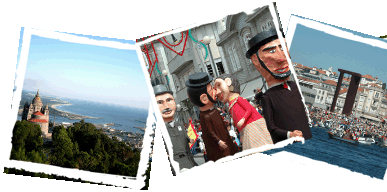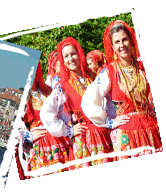 |

Festivals of Viana do Castelo, 3 days
TravelTailors offers you a unique cultural experience: participating in a great popular festival in Portugal. The festivities in honour of Our Lady of Agony are the most popular and lively around all of Minho. They take place in the third week of August and include several parades with big heads Gigantones, zés-pereiras and a diverse choice of regional costumes and gold jewellery.
TravelTailors offers you a unique cultural experience: participating in a great popular festival in Portugal. The festivities in honour of Our Lady of Agony are the most popular and lively around all of Minho. They take place in the third week of August and include several parades with big heads Gigantones, zés-pereiras and a diverse choice of regional costumes and gold jewellery.
DAY 1 PORTO - VIANA DO CASTELO
| ||
Arrival in Porto.
Porto is a charming town, situated on the slopes of the Douro River and very near to its mouth. Classified as a UNESCO World Heritage Site, thanks to its beautiful monuments and historic buildings such as the imposing Cathedral or the Tower of Clerics, Porto is the second largest city of Portugal and has superb views over the river and the world famous Port Wine Cellars on the opposite bank, in Vila Nova de Gaia. The city provides a harmonious synthesis of ancient and contemporary attractions. Perched on top of hills and clinging to cliffs, attractive buildings, bridges and lamps guard the Douro River for centuries. Fiercely proud of their heritage, the citizens of this merchant town have invested their blood and sweat on their commerce and wine. Porto is a city ready for work and ready for fun. Nightclubs and restaurants mingle with cathedrals, churches and museums in narrow alleys and broad avenues. There are many cafes around the city, where you can relax after climbing the many hills of Porto. On the rooftops there are red tiles and the facades are often tiled. The city of Porto is very compact, which is great to do some exploring on foot, as long as you don't mind making an effort going uphill. Until 18h30: Visit to the cellars of Porto and wine tasting. Port Wine is a fortified wine of world fame, produced exclusively from grapes from the Douro Wine Region, about 100 km east of Porto. The wine took the name of Porto, but it's on the opposite bank of the Douro in Gaia, that are installed fifteen cellars, greater temples of this nectar. The visit includes tastings of different varieties . Suggestion: Rabelo boat ride on the River Douro. The Rabelo boat ride on the river Douro, through the six bridges, is perfect to have some beautiful city views and to know a little of its history in a different way; after all, the river held a key role in local development over the centuries. The Maria Pia Bridge, built in 1886 by Eiffel, stands out. The boat leaves us on the edge of Gaia, where there are several Port Wine Cellars. Journey to Viana do Castelo. Located near the mouth of the Lima River, 65 km north of Porto, Viana do Castelo was founded in the 13th century by Afonso III, King of Portugal, under the name of Viana da Foz do Lima. From the shipyards of Viana, ships and caravels have left to the routes of India and the Americas. By the 16th century, the town was solely of the people, with the nobility not being able to settle here. Finally opening its doors, Viana enriched itself with emblazoned palaces, convents, churches and fountains that make up a remarkable patrimonial heritage, worthy of visit. Beautiful city, outgoing and cheerful, Viana do Castelo has been able to conserve its rich tradition of popular roots. Around 20h30: Suggestion for dinner in traditional Portuguese food restaurant, in Viana do Castelo. A renowned, award-winning restaurant with excellent Minho specialties, this TravelTailors choice offers a plentiful and well prepared cuisine, thus justifying its high number of customers. It is a good opportunity to experience Vinho Verde, which is unique in the world; naturally light and airy, with low alcohol content, and therefore fewer calories, Vinho Verde is a fruity wine, easy to drink, great as an aperitif or in harmony with light and balanced meals: salads, fish, seafood or white meat. Overnight at the hotel of the selected category. | ||
DAY 2 VIANA DO CASTELO
| ||
Visit to Temple of Santa Luzia.
The Temple of Santa Luzia is situated on the hill of the same name, where one can see a unique view of the region, which combines the sea, the river Lima with its valley, and the whole mountain complex - one of the best panoramas of the world, according to National Geographic. The project of the church is by the architect Miguel Ventura Terra, with obvious inspiration from the Basilica of Sacre Coeur in Montmartre, Paris. Built on a plant in the form of a Greek cross, its architecture has Neo-Romanesque, Byzantine and Gothic elements. Suggestion: descent into the city by funicular. Suggestion: visit of the city on foot. Up until the 16th century, the town was solely of the people, with the nobility not being able to settle here. Finally opening its doors, Viana enriched itself with emblazoned palaces, convents, churches and fountains that make up a remarkable patrimonial heritage, worthy of visit. In 1848, Queen D. Maria II raised Viana the city with the new name of Viana do Castelo. Around 12h30: Suggestion for lunch at a traditional cuisine restaurant, in Viana do Castelo. Housed in a palace in the historic center, this is one of those restaurants where you just feel like being at. It's comfortable, the decor follows the solemnity of the space and the service only magnifies the good flavors of the traditional cuisine that is practiced here. With several maritime inspirations, on the menu you'll find the Viana's Traditional Stuffed Crab, natural Lobsters, and the Bass Cataplana and Chef's Rice Fish. Mandatory are, the Codfish, the Sarrabulho Porridge with Fried Pork and Serra d'Arga's Roasted Lamb. Don't you dare leaving without trying the French Toast, present on the menu throughout all year. Participation in the emblematic Celebrations of Viana do Castelo. The festivities in honor of Our Lady of Agony are the most popular and lively around all of Minho. They take place in the third week of August and include several parades with big heads, Gigantones, zés-pereiras, floats and a diverse choice of regional costumes, especially the necklaces, earrings and gold bracelets of women. This is considered the festival of the pilgrimage festivals. The cult of Our Lady of Agony goes back to the 18th century, with the first written reference to this event dating from 1744. Its essential trait is the devotion of the people of the sea, that reciprocate the graces received during storms or shipwrecks. Hence the main float was traditionally carried by fishermen and only since 1968 a fluvial procession began to be made, with the image of the saint, up the river Lima. Besides all these events, the fireworks, launched by the river Lima, are a unique show. Throughout all day there will be countless activities and parades to delight anyone's view. The Historical and Ethnographic Parade takes place on the Avenue of the Combatants of the Great War, and the parade of costumes and stewardship go through several city streets. They are identified by the covered and worked towels that are hung on the balconies of the inhabitants. Only since 1893 have Zabumba and Zés P'reiras, as well as Gigantones and Cabeçudos, entered the Pilgrimage. Colossal and grotesque figures, the Gigantones betray their remote and popular origin. Kings of the Party, they liven up the consecrated Pilgrimage revues that take place every year, at noon, on the Republic Square to the sound of a hundred bombs - and constitute the most garrulous and lurid procession of Alto Minho's imagery. Be amazed by the amount of gold that is worn these days and that parades around town! You can't leave without tasting the fried pastry Bola de Berlim from the Natário Bakery, known as the best in Portugal. Around 20h00: Suggestion for dinner in traditional cuisine restaurant, in Viana do Castelo. Located opposite the River Lima, near the monument of the Viennese seaman Pêro do Campo Tourinho, the restaurant is housed in a centennial sunny manor, known as Casa do Campo da Feira, near the old shipyard facilities of the city. It has a decor of accentuated medieval inspiration, which gives it a unique beauty and a sense of permanent well-being. Over the years, it has come to prominence for the excellence of its service, as well as for its cuisine of notice. Fish and seafood dishes are not to be missed, especially the fish in the oven and lobster bread soup with prawns. Always accompanied by a wonderful wine, like one should in Minho! Continuation of participation in the festivities. 24h00: Fireworks in Old Bridge. Overnight at the hotel of the selected category. | ||
DAY 3 VIANA DO CASTELO - PONTE DE LIMA - CIDADE DE DESTINO
| ||
Visit to the flowered carpets.
Throughout the morning and until the passage of the Procession to the Sea, we can appreciate the painstaking and dedicated work of the people of Ribeira on the floral carpets that are presented on the streets, the result of devotion to Our Lady of Agony and that throughout the night before, moved its residents. The variety of colors, the softness of the carpets of flowers, the delicacy of preparation, turn the hard floor of the streets of Ribeira into the most beautiful and polychrome carpet. Journey to Ponte de Lima. In the center of a rich agricultural region, where it's produced the famous Green Wine, its heritage includes a large number of manor houses and stately homes. This traditional village records fortnightly great animation on the sandy banks of the river, when a fair is organized, which originated in the Middle Ages. Around 12h30: Suggestion for lunch in traditional Portuguese food restaurant, in Ponte de Lima. The granite walls of this TravelTailors' proposal keep quality cuisine, a true gastronomic temple. Warm up your senses with the arrival of the entrées, especially for pataniscas and the sausages of Ponte de Lima. On cold days, the fireplace is almost inspiring and foreshadows several specialties that are the delight of diners. Namely, the roasted lamb, the Minho sarrabulho and the divine cod with cornbread. The wine list, of reasonable prices and well provided with green wines, magnifies the list of delicacies, which ends with the already distinct pear borrachona. Journey to the city of destination. | ||

No comments:
Post a Comment